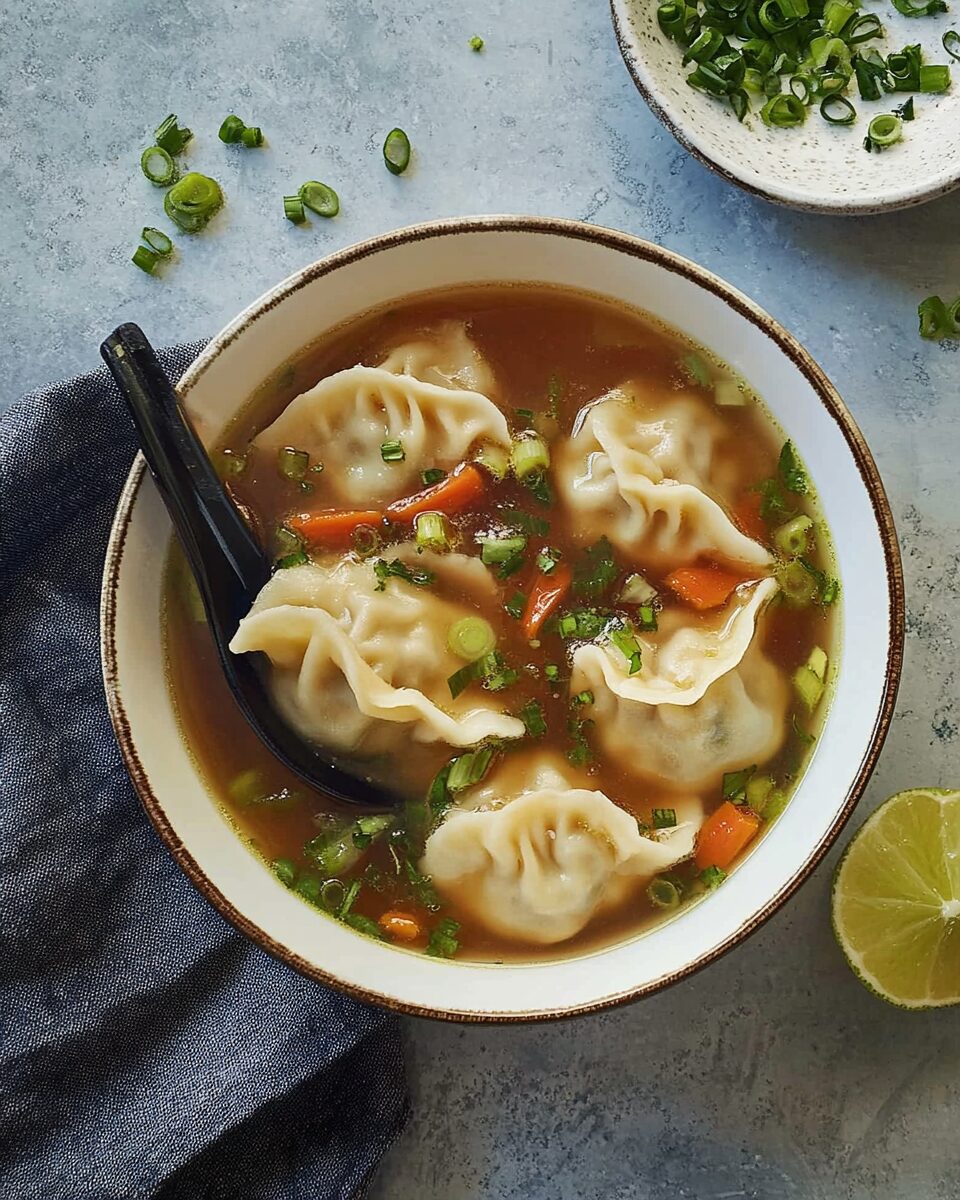This Vegetarian Dumpling Soup is the ultimate comfort food, brimming with a delightful blend of textures and flavors. The spicy miso broth is rich and soothing, perfectly complementing the soft, tender dumplings and the fresh, crunchy veggies. It’s a harmonious mix that will warm you up from the inside out.
With its quick preparation and wholesome ingredients, this soup is an ideal meal for busy weeknights or cozy weekends. It’s not only delicious but also nourishing, offering a satisfying and healthy alternative to takeout. This soup is a celebration of Asian-inspired flavors, making it a delightful addition to your dinner table.
Full Recipe:
- 1 tablespoon sesame oil
- 2 tablespoons fresh ginger, minced
- 4 garlic cloves, minced
- 1 medium onion, chopped
- ½ cup red cabbage, chopped
- ½ cup shredded carrots
- ½ cup red bell pepper, chopped
- 8 oz. mushrooms, halved
- 6 cups Miso Broth
- 1.5 lb. bag frozen vegetarian gyoza (or dumplings, wontons, pot stickers)
- 1 lime, juiced
- 1 tablespoon chili garlic paste
- ¼ cup green onions, chopped
- ¼ cup cilantro, chopped
- ⅛ teaspoon salt (adjust to taste)
Directions:
- Warm the sesame oil in a soup pot over medium heat. Add onions, ginger, and garlic. Sprinkle with salt and sauté for 3 minutes until the onions turn golden brown.
- Add the cabbage, carrots, bell pepper, and mushrooms. Sauté for another 3 minutes until the mushrooms start to brown.
- Pour in the miso broth and stir well. Increase the heat to bring it to a boil.
- Add the frozen gyoza and stir. Cover the pot and let it simmer for 3 minutes.
- Once the gyoza are fully cooked, turn off the heat. Add lime juice and chili garlic paste, then mix well.
- Ladle the soup into bowls and garnish with green onions and cilantro. Serve warm and enjoy!
Prep Time: 10 minutes | Cooking Time: 15 minutes | Total Time: 25 minutes
Kcal: 300 kcal | Servings: 6 servings
Recipe Origins and Inspiration
This Vegetarian Dumpling Soup draws inspiration from Asian cuisine, particularly the comforting bowls of dumpling and wonton soups enjoyed in various regions across Asia. The use of miso broth, ginger, and garlic provides a deep, umami-rich flavor that is both soothing and invigorating. The dumplings, often referred to as gyoza or potstickers, are a staple in many Asian kitchens and add heartiness to this dish. By incorporating a blend of fresh vegetables, this soup not only satisfies your taste buds but also provides a nutritious meal option that’s perfect for cold nights or when you need a pick-me-up.
Health Benefits
This soup is not only delicious but also packed with nutritional benefits:
- Vegetables: Red cabbage, carrots, bell peppers, and mushrooms offer a rich source of vitamins, minerals, and antioxidants. They boost the soup’s fiber content, promoting digestive health.
- Miso Broth: Miso is fermented soybeans, which contain probiotics that support gut health and strengthen the immune system. It’s also a good source of protein, vitamins (especially B vitamins), and essential minerals like zinc and copper.
- Ginger and Garlic: These ingredients are known for their anti-inflammatory and immune-boosting properties. They add a warm, aromatic flavor to the soup while aiding in digestion and helping fight off colds and flu.
- Dumplings: The dumplings provide a satisfying texture and are often filled with vegetables or tofu, offering additional protein to make this a complete and filling meal.
Versatility and Customization
This soup is incredibly versatile and can be easily adapted to suit different dietary needs or preferences:
- Protein Additions: While this recipe is vegan, you can add tofu, tempeh, or even edamame for a boost of plant-based protein. If you’re not strictly vegetarian, feel free to include some sliced chicken, shrimp, or beef for a more substantial soup.
- Broth Variations: If you don’t have miso broth, you can substitute it with vegetable or even chicken broth for a different flavor profile. Add soy sauce or tamari for extra umami.
- Spice Level: The chili garlic paste gives this soup a nice kick. If you prefer a milder soup, reduce the amount or skip it entirely. For those who love extra heat, add some sliced fresh chilies or a dash of hot sauce.
Serving Suggestions
- Side Dishes: This soup pairs wonderfully with a side of steamed or stir-fried vegetables, a simple cucumber salad, or a serving of rice. For a more filling meal, serve it alongside some crispy spring rolls or a light tofu stir-fry.
- Garnishes: Customize each bowl with your favorite toppings. Consider adding a sprinkle of sesame seeds, a drizzle of sesame oil, a dash of soy sauce, or even some sriracha for an extra flavor boost.
- Accompaniments: Enjoy this soup with a cup of green tea or a refreshing glass of sparkling water with lime.
Storage and Meal Prep Tips
- Make-Ahead: You can make the soup base (without the dumplings) in advance and store it in the refrigerator for up to 3 days. When you’re ready to serve, simply reheat the broth and add the dumplings to cook.
- Freezing: This soup is freezer-friendly. Prepare the soup without the dumplings, and freeze the broth and vegetables in an airtight container for up to 3 months. When ready to eat, defrost, bring to a boil, and add the dumplings.
- Leftovers: Store any leftover soup in an airtight container in the fridge for up to 3 days. Reheat gently on the stovetop or in the microwave. If the dumplings absorb too much broth, you can add a splash of water or broth when reheating.
Cooking Tips
- Use Frozen Dumplings: Using frozen dumplings is a time-saver, and they cook quickly in the soup. Do not thaw the dumplings before adding them to the boiling broth to maintain their texture.
- Sauté for Flavor: Sautéing the onions, garlic, and ginger at the beginning helps to release their aromatic flavors, which infuses the broth with a deep, savory taste.
- Customize Veggies: Feel free to change up the vegetables based on what’s in season or what you have on hand. Baby bok choy, spinach, kale, zucchini, or snap peas would all work well in this soup.
Dumpling Varieties and Selection
- Types of Dumplings: Dumplings come in various forms, including gyoza, wontons, potstickers, and momo. For this soup, vegetarian gyoza are used, which are typically filled with vegetables and seasonings. However, feel free to experiment with other types like mushroom-filled wontons or tofu-stuffed potstickers to vary the texture and flavor.
- Where to Find: Most supermarkets carry a selection of frozen dumplings in the Asian foods section. For the best variety, visit an Asian grocery store where you can find dumplings with different fillings, including vegan, vegetarian, and gluten-free options.
- Homemade Option: If you have more time, consider making homemade dumplings. You can customize the filling with your favorite ingredients such as tofu, cabbage, mushrooms, and seasonings. Homemade dumplings can be prepped in batches and frozen, making them easy to cook later.
Broth Enhancements
- Miso Broth: Miso broth is the heart of this recipe, offering a deep umami flavor. Miso paste, made from fermented soybeans, is rich in probiotics, which support gut health. When shopping for miso paste, you can choose between white (milder and sweeter) and red (stronger and saltier) varieties. For this soup, a lighter miso is ideal to complement the delicate flavors of the dumplings.
- Broth Customization: If you want a heartier broth, consider adding ingredients like a splash of soy sauce or tamari (for gluten-free), a dash of rice vinegar for acidity, or a spoonful of gochujang for a spicy kick. To enhance the broth’s depth, you can also add dried seaweed, sliced shiitake mushrooms, or a dash of sesame oil.
Garnishing Tips
- Crispy Elements: Add some crunch by garnishing the soup with crispy fried onions, garlic chips, or roasted sesame seeds. These elements add texture and an extra layer of flavor to the soup.
- Herbs and Greens: Fresh herbs like cilantro, Thai basil, or mint can elevate the dish’s aroma. You can also add a handful of baby spinach or kale into the soup just before serving to increase its nutrient content.
- Citrus Zing: Besides lime juice, you can experiment with other citrus elements such as yuzu, lemon zest, or a splash of orange juice for a unique twist that brightens the overall taste.
Serving and Presentation Ideas
- Serving Bowls: Present the soup in deep bowls to highlight its hearty nature. Use bowls with wide rims to showcase the vibrant vegetables, dumplings, and garnishes.
- Accompaniments: Serve the soup alongside traditional Asian sides like steamed rice, edamame, or a light salad with sesame dressing. For an authentic experience, you can also serve it with Chinese tea or sake.
- Noodle Addition: For a more filling meal, add some cooked noodles to the soup. Ramen, udon, or soba noodles work well and turn this dish into a more substantial one-bowl dinner.
Cultural Context and Inspiration
Dumpling soups have a rich cultural heritage in many Asian cuisines. In China, dumplings (jiaozi) are a symbol of wealth and prosperity, often enjoyed during the Lunar New Year. Japanese gyoza soups are popular comfort foods, typically featuring a clear or miso-based broth. This vegetarian version brings together the comforting essence of traditional dumpling soup with a modern, health-conscious twist.
Tips for a Cozy Meal Experience
- Meal Ritual: Create a cozy atmosphere when serving this soup. Light candles, play some soft music, and serve the soup steaming hot. It’s a wonderful way to unwind after a busy day and enjoy a warming, nourishing meal.
- Perfect for Gatherings: This soup is an excellent choice for gatherings or dinner parties. It’s easy to prepare in large quantities, and guests can enjoy customizing their bowls with various garnishes. Set up a “dumpling soup bar” where guests can add their favorite toppings like chili oil, soy sauce, or extra veggies.
Dietary Adaptations
- Gluten-Free: Use gluten-free dumplings and miso paste to make the soup suitable for those with gluten sensitivities or celiac disease. Additionally, ensure any added soy sauce or broth is certified gluten-free.
- Low-Sodium: To control the salt content, opt for low-sodium miso paste and broth. You can further reduce sodium by seasoning with a splash of fresh lime juice or a sprinkle of herbs instead of adding extra salt.
- Keto-Friendly: For a low-carb version, replace the dumplings with tofu cubes or a variety of low-carb vegetables like zucchini, spinach, or bok choy.
Variations and Twists
- Creamy Variation: For a creamy twist, stir in a splash of coconut milk or cashew cream. This will give the soup a richer texture and a slight sweetness that balances the savory elements.
- Sour Dumpling Soup: For a tangier version, add a tablespoon of rice vinegar or apple cider vinegar to the broth. This adds a refreshing sourness that pairs well with the savory dumplings.
- Dumpling Stew: To make this soup more like a stew, reduce the amount of broth and add extra vegetables such as sweet potatoes, baby corn, or edamame. This thickened version is perfect for a more substantial meal.
Storage and Reheating Instructions (Detailed)
- Refrigeration: Store leftover soup in an airtight container in the refrigerator for up to 3 days. When reheating, add a splash of broth or water to thin the soup if it has thickened.
- Freezing: If planning to freeze, it’s best to freeze the broth and vegetables separately from the dumplings. Dumplings can become too soft when frozen in the soup. Freeze the broth in an airtight container for up to 2 months. When ready to serve, heat the broth and add fresh or frozen dumplings to cook.
- Reheating Tips: Reheat the soup on the stovetop over medium heat, stirring occasionally until warmed through. Avoid microwaving the soup for too long, as it can cause the dumplings to become mushy.
Cooking with Kids
Involve children in the kitchen by having them help with simple tasks like adding the dumplings to the pot or garnishing the soup. This is a fun way to teach them about cooking and different flavors. Plus, they’re more likely to enjoy the meal if they’ve helped make it!
Conclusion
This Vegetarian Dumpling Soup is a celebration of comforting flavors and wholesome ingredients, offering a delightful and nourishing experience in every bowl. Its adaptability makes it suitable for various dietary preferences, while its rich, savory profile ensures it remains a crowd-pleaser. Whether you’re seeking a quick weeknight dinner, a cozy meal for a rainy day, or an impressive dish for guests, this soup is a versatile and delightful option. With its blend of vibrant vegetables, tender dumplings, and aromatic broth, it’s a recipe that warms both the body and the soul.






